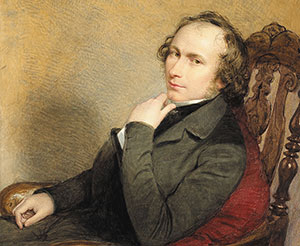Burton at the National Gallery
Published in Issue 6 (November/December 2017), News, Volume 25A look at Irish historical figures associated with Sir Frederic William Burton RHA (1816–1900), featured in the current exhibition at the National Gallery of Ireland (NGI).
By Marie Bourke

Above: Burton’s watercolour of William Stokes (1804–78), an eminent medical figure and Regius Professor of Physic at Trinity College, Dublin. (TCD)

Above: Thomas Davis (1814–45). Burton was shocked by the death of his friend. He executed this posthumous portrait in graphite and sat on the memorial committee for the statue of Davis, executed by John Hogan (1800–58) in 1852. (NGI)
William Stokes was an active member of the Royal Irish Academy with Petrie and Burton. He was deeply interested in history, art and the study of ancient Irish monuments. Burton and Petrie regularly visited the Stokes family home at 5 Merrion Square, where they discussed art and archaeological matters and met important people. In 1869 Stokes published a biography of Petrie, The life and labours in art and archaeology of George Petrie. Stokes’s talented children included Whitley, a Celtic scholar and linguist, and Margaret, an antiquarian and art historian. Margaret’s excursions with Petrie, Burton and her father fuelled a lifelong interest in Irish history and archaeology. While publishing in her own right, Margaret also edited and published work for Petrie and the earl of Dunraven that included Burton’s illustrations. Her incomplete biography of the artist’s life is in the NGI Archives and she bequeathed six paintings by Burton to the gallery in 1900.
In 1858, following seven years in Germany, Burton settled in London, from where he kept in contact with Irish friends and exhibited at the Dublin International Exhibition (1853). In 1866 he presented George Mulvany, director, with four Old Master drawings for the NGI. In 1872, aware that Henry Doyle was trying to establish a National Historical Portrait Gallery, he presented the NGI with a series of portrait drawings: William Henry Harvey 1811–1866, Botanist (NGI.2030), Professor James MacCullagh 1809–1847, Mathematician (NGI.2031), Thomas Osborne Davis 1814–1845 (NGI.2032 and 3286) and James Clarence Mangan 1803–1849, Poet (NGI.2033).
It was during his tenure as director of the National Gallery, London (1874–94), that Burton first met Augusta Gregory (1852–1932); her husband, Sir William Gregory, was a gallery trustee. In 1892, after Sir William’s death, Lady Gregory became a friend of Burton’s, as they shared an interest in Irish history and folklore; she kept him updated on Irish writers and poets, including Douglas Hyde and W.B. Yeats, who impressed Burton greatly. In 1899 Burton became a guarantor of the Irish Literary Theatre. In his final years he presented Lady Gregory with some paintings from Clare and Connemara, included in the Burton exhibition. In 1900, following the artist’s death, Sir Walter Armstrong mounted a loan exhibition of the works of Burton at the NGI (6–31 December), which was attended by 8,000 people and sold 800 catalogues.
The NGI exhibition Frederic William Burton For the Love of Art, which runs from 25 October 2017 until 14 January 2018, includes work by John Everett Millais, Dante Gabriel Rosetti, Edward Burne-Jones, Ford Maddox Brown (see pp 34–6), Daniel Maclise and William Mulready. There is an accompanying illustrated book and public engagement programme; see www.nationalgallery.ie.
Marie Bourke is curator of the Burton Exhibition at the National Gallery of Ireland.
















